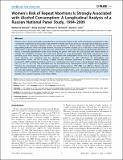Files in this item
Women's risk of repeat abortions is strongly associated with alcohol consumption : a longitudinal analysis of a Russian National Panel Study, 1994–2009
Item metadata
| dc.contributor.author | Keenan, Katherine | |
| dc.contributor.author | Grundy, Emily | |
| dc.contributor.author | Kenward, Michael G. | |
| dc.contributor.author | Leon, David A. | |
| dc.date.accessioned | 2017-08-01T10:30:09Z | |
| dc.date.available | 2017-08-01T10:30:09Z | |
| dc.date.issued | 2014-03-26 | |
| dc.identifier | 250544726 | |
| dc.identifier | da99f888-7153-40db-ab35-8fd09b7e7e3a | |
| dc.identifier | 84899975799 | |
| dc.identifier.citation | Keenan , K , Grundy , E , Kenward , M G & Leon , D A 2014 , ' Women's risk of repeat abortions is strongly associated with alcohol consumption : a longitudinal analysis of a Russian National Panel Study, 1994–2009 ' , PLoS One , vol. 9 , no. 3 , e90356 . https://doi.org/10.1371/journal.pone.0090356 | en |
| dc.identifier.issn | 1932-6203 | |
| dc.identifier.other | RIS: 5 | |
| dc.identifier.other | ORCID: /0000-0002-9670-1607/work/35292662 | |
| dc.identifier.uri | https://hdl.handle.net/10023/11335 | |
| dc.description | KK was funded by a United Kingdom Economic and Social Research Council PhD Studentship. | en |
| dc.description.abstract | Abortion rates in Russia, particularly repeat abortions, are among the highest in the world, and abortion complications make a substantial contribution to the country's high maternal mortality rate. Russia also has a very high rate of hazardous alcohol use. However, the association between alcohol use and abortion in Russia remains unexplored. We investigated the longitudinal predictors of first and repeat abortion, focussing on women's alcohol use as a risk factor. Follow-up data from 2,623 women of reproductive age (16–44 years) was extracted from 14 waves of the Russian Longitudinal Monitoring Survey (RLMS), a nationally representative panel study covering the period 1994–2009. We used discrete time hazard models to estimate the probability of having a first and repeat abortion by social, demographic and health characteristics at the preceding study wave. Having a first abortion was associated with demographic factors such as age and parity, whereas repeat abortions were associated with low education and alcohol use. After adjustment for demographic and socioeconomic factors, the risk of having a repeat abortion increased significantly as women's drinking frequency increased (P<0.001), and binge drinking women were significantly more likely to have a repeat abortion than non-drinkers (OR 2.28, 95% CI 1.62–3.20). This association was not accounted for by contraceptive use or a higher risk of pregnancy. Therefore the determinants of first and repeat abortion in Russia between 1994–2009 were different. Women who had repeat abortions were distinguished by their heavier and more frequent alcohol use. The mechanism for the association is not well understood but could be explained by unmeasured personality factors, such as risk taking, or social non-conformity increasing the risk of unplanned pregnancy. Heavy or frequent drinkers constitute a particularly high risk group for repeat abortion, who could be targeted in prevention efforts. | |
| dc.format.extent | 8 | |
| dc.format.extent | 250664 | |
| dc.language.iso | eng | |
| dc.relation.ispartof | PLoS One | en |
| dc.subject | H Social Sciences (General) | en |
| dc.subject | RA0421 Public health. Hygiene. Preventive Medicine | en |
| dc.subject | SDG 3 - Good Health and Well-being | en |
| dc.subject.lcc | H1 | en |
| dc.subject.lcc | RA0421 | en |
| dc.title | Women's risk of repeat abortions is strongly associated with alcohol consumption : a longitudinal analysis of a Russian National Panel Study, 1994–2009 | en |
| dc.type | Journal article | en |
| dc.contributor.institution | University of St Andrews. Geography & Sustainable Development | en |
| dc.identifier.doi | https://doi.org/10.1371/journal.pone.0090356 | |
| dc.description.status | Peer reviewed | en |
This item appears in the following Collection(s)
Items in the St Andrews Research Repository are protected by copyright, with all rights reserved, unless otherwise indicated.

